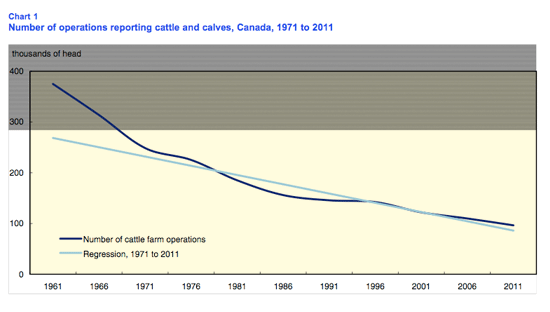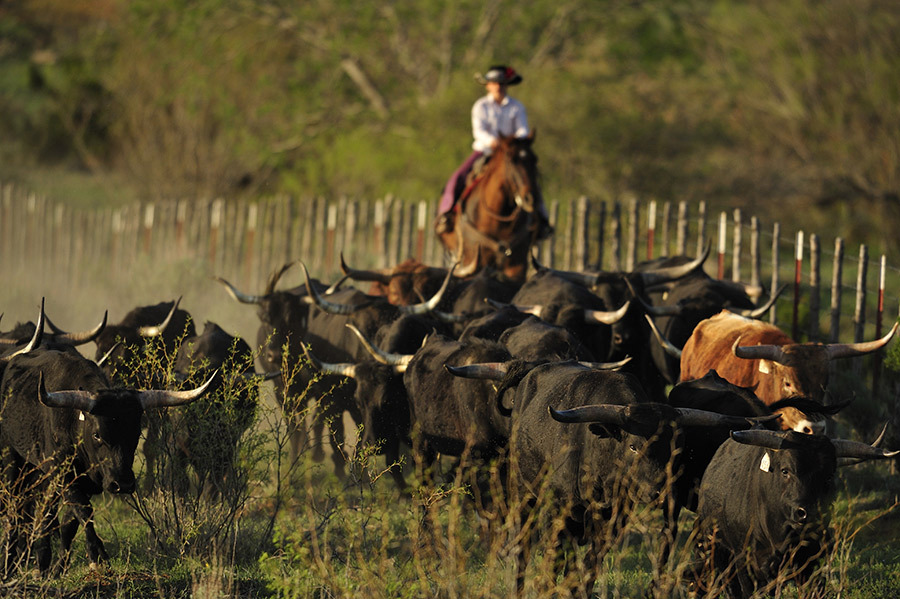



Canadian Cattle Herd Decreases
Cattle inventories fell despite an improvement in prices during 2010. Canadian cattle farmers had just under 12.5 million cattle on their farms as of January 1, 2011, down 3.4 per cent from the same date a year earlier.The cattle herd has declined steadily since the peak in 2005. The inventory of beef cows fell 2.7 per cent , continuing a downward trend that started in January 2006, as farmers continue to cull their herds. The number of replacement heifers increased 4.5 per cent in the western provinces and declined 6.5 per cent in the East. Overall, inventories of beef replacement heifers rose 2.9 per cent . The increase in replacement heifers indicated producers were replenishing the herd with younger cows. However, breeding herd replacements have not offset the beef cows decline in 2010 and cattle producers are reporting lower calving expectations during January to June 2011 compared with the same period last year. Farmers reported a 0.6 per cent year over year increase in the dairy cow herd to meet milk production quotas that have risen slightly over the last several months of 2010.
Text table 1 - Cattle inventories
| January 1 2010r | July 1 2010r | January 1 2011 | July 2010 to January 2011 | January 2010 to January 2011 | |
|---|---|---|---|---|---|
| thousands of head | percentage change | ||||
| Canada | 12,905.0 | 13,975.0 | 12,460.0 | -10.8 | -3.4 |
| East | 3,331.0 | 3409.0 | 3250.0 | -4.7 | -2.4 |
| ---Atlantic | 255.1 | 243.1 | 245 | 0.8 | -4.0 |
| ---Quebec | 1310.0 | 1360.0 | 1280.0 | -5.9 | -2.3 |
| ---Ontario | 1765.9 | 1805.9 | 1725.0 | -4.5 | -2.3 |
| West | 9574.0 | 10566.0 | 9210.0 | -12.8 | -3.8 |
| ---Manitoba | 1220.0 | 1350.0 | 1160.0 | -14.1 | -4.9 |
| ---Saskatchewan | 2,645.0 | 3,055.0 | 2,580.0 | -15.5 | -2.5 |
| ---Alberta | 5,190.0 | 5,505.0 | 4,950.0 | -10.1 | -4.6 |
| ---British Columbia | 519.0 | 656.0 | 520.0 | -20.7 | 0.2 |
Cattle on feeding operations in Canada were down 0.7 per cent at January 1, 2011 from one year earlier. Feeding operations include feedlots and backgrounding operations that do not report a breeding herd. The feeder supply (heifers and steers for growing on) have fallen 5.3 per cent from a year ago. Total feeder and calves supply are down in Canada (-0.7 per cent ) and the United States (-3.6 per cent ) at January 1. In 2010, cattle and calf slaughter totalled 3.7 million head, up 0.9 per cent from 2009 but down 2.9 per cent from 2008. Slaughter plant capacity in Saskatchewan was reduced in 2010 but capacity remains in Canada to handle current slaughter requirements. On average, 3.9 million head were slaughtered in Canada in each of the previous five years.
There were 1.1 million head of cattle and calves exported in 2010, up 4.7 per cent from 2009, but down 30.1 per cent from 2008. Fed cattle (ready for slaughter) exports were up in 2010 while feeder exports were down. Tight feeder supply, a near par Canadian dollar and a comparative feeding advantage in Canada versus the United States, were some of the contributing factors to the export reduction of feeders. Corn price increases were larger than barley price increases in 2010 giving Canada a slight feed advantage over the United States; as feeder cattle are fed corn in the United States and barley in Canada. Since 2008, the Country of Origin Labelling regulation in the United States has reduced the ability for American feedlots to accept and market Canadian feeder cattle. Non-fed cattle (slaughter cows and bulls) are mainly imported into the United States by meat processors that are producing large volumes of ground beef. The labelling requirements are more flexible in the United States to account for multiple country sources for ground beef. Non-fed cattle exports were steady from 2009 to 2010.
The 2010 growing season was a difficult one for Western producers. Manitoba, Saskatchewan and southern Alberta received almost 70 per cent above normal rainfall throughout the spring, resulting in the regions wettest spring on record. The rains continued across most of the prairies throughout the summer, with the summer rainfall 28 per cent above normal levels. The persistent rains were compounded by cooler than normal temperatures over the summer months across the Prairies, which kept fields soggy and haying conditions challenging.
Poor grain growing conditions in Canada, as well as in other major grain production areas of the world, tightened the feed grain supply in 2010. Lower grain production combined with strong grain demand for ethanol production contributed to raising feed grain prices by the end of 2010. This added further pressure to the Canadian livestock industry as feed is a large component of production costs.
Cattle slaughter prices improved throughout 2010 across Canada. Tight feeder and fed cattle supply were supportive to prices. The farm product price index for cattle indicated that prices strengthened in 2010, but were still below the pre-BSE years.
An estimated 96,430 farms reported cattle and calves as of January 1, 2011, down 2.9 per cent from the same date last year and down 5.3 per cent from two years earlier. Since 2004, beef producers have accounted for more than 84 per cent of the number of cattle farm operations in Canada.

Beef cattle production takes place on three main cattle farm types. At January1, 2011 there were 67,300 cow-calf operations, 11,525 cow-calf backgrounding operations, and 2,775 feeding operations.
The bulk of Canadian beef cow inventories (90.9 per cent ) are on specialized cow-calf operations. Cow-calf operations sell calves to backgrounding or feeding operations. Backgrounding operations, which include feeder and stocker/finishing operations, usually keep cattle throughout the winter to be fed a low energy ration like forage. Backgrounding operations sell cattle the year after as yearlings, to be finished on feeding operations, or as fed cattle ready to be slaughtered. Usually more than half the heifers for slaughter and steers inventories in Canada,at January 1 or July 1, are reported to be on feeding operations. Feeder steers and heifers on feeding operations are fed a high energy ration like grains to be finished to slaughter weight. The Western provinces have 30.6 per cent of the total feeding operations and account for 75.4 per cent of the Canadian cattle inventory on feeding operations.
There were 16,490 farms reporting dairy cattle at January 1, 2011 with 85.7 per cent of those operations located in Eastern Canada. The dairy farms which produce milk everyday accounted for 15,027 operations. There are 1,660 farms in Canada that keep a dairy and a cow-calf (beef)herd on the same operation. Only 25 per cent to 30 per cent of the calves born on dairy farms are kept for breeding purposes. In Quebec and Ontario, dairy operations sell bob calves(calves not kept for breeding)to veal farms. The number of operations for veal production was 1,235 farms at January1, 2011. In other provinces,bob calves are fed as heifers for slaughter or steers. Good female calves are kept for milk production on the dairy farms or sold to specialized heifer farms. In Quebec and Ontario,there were 228 specialized milk heifer farms.


